
Go to Part 1
I thought this would be the last set of these capsule reviews, in which my goal is to give a very high overview of my thoughts/impressions of each book, but I just recently discovered that Rhodarin Press has put out a whole suite of Avernus-related PDFs, so I’ll be taking a peek at those in the near future, too.
These reviews were written as part of my survey of Descent Into Avernus-related material on the Dungeon Masters Guild while working on the Alexandrian Remix of the campaign. Unless otherwise noted, the material has not been playtested.
You may also want to review this Guide to Grades at the Alexandrian. The short version: My general philosophy is that 90% of everything is crap, and crap gets an F. I’m primarily interested in grading the 10% of the pile that’s potentially worth your time. Anything from A+ to C- is, honestly, worth checking out if the material sounds interesting to you. If I give something a D it’s pretty shaky. F, in my opinion, should be avoided entirely.
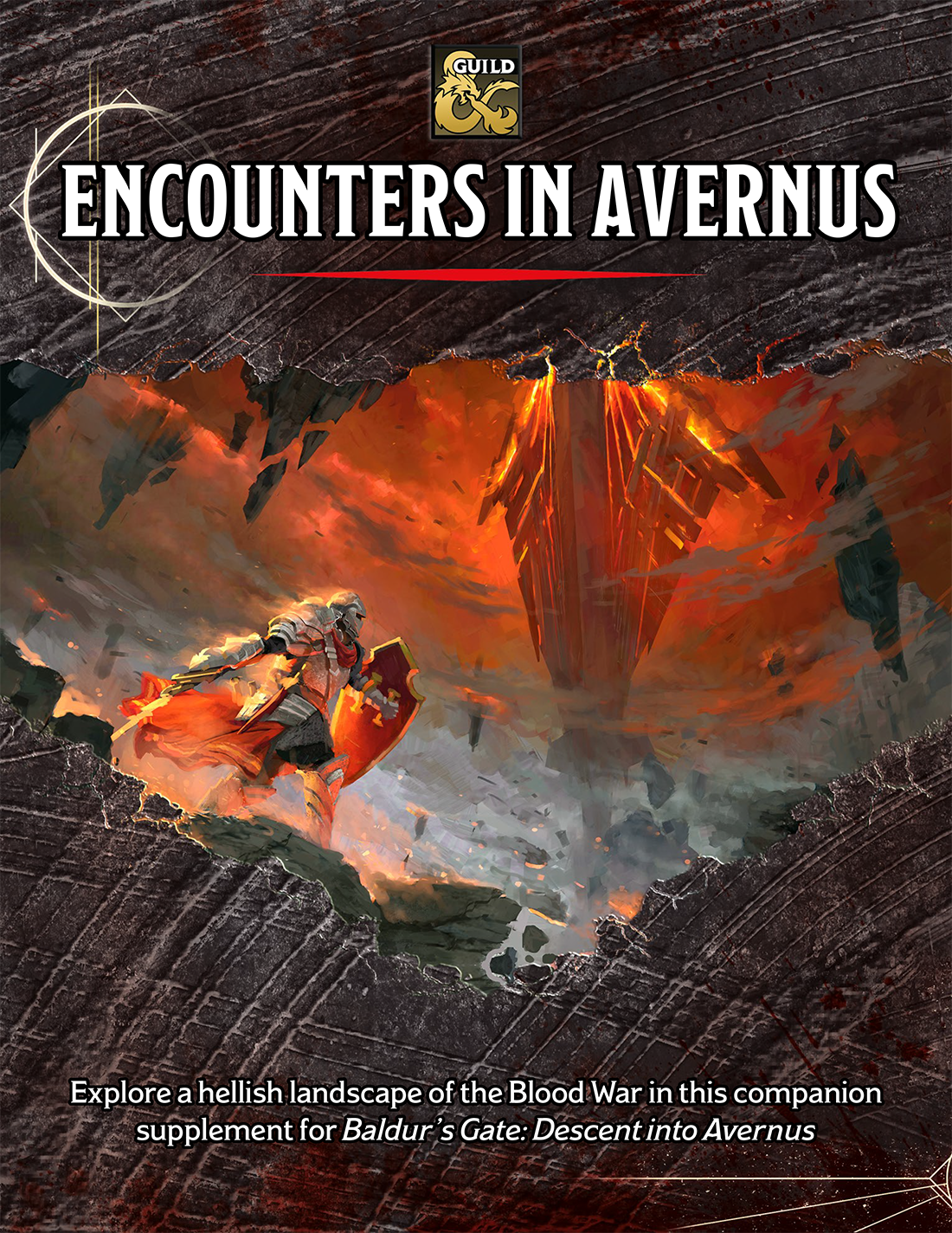 ENCOUNTERS IN AVERNUS: I’ve previously talked about how I found Baldur’s Gate: City Encounters to be a very disappointing offering in comparison to Waterdeep: City Encounters. I’m pleased to report that Encounters in Avernus – designed by M.T. Black, James Haeck, James Introcaso, Rich Lescouflair, Shawn Merwin, and Ashley Warren – is much closer to the Waterdeep volume in terms of its value and quality.
ENCOUNTERS IN AVERNUS: I’ve previously talked about how I found Baldur’s Gate: City Encounters to be a very disappointing offering in comparison to Waterdeep: City Encounters. I’m pleased to report that Encounters in Avernus – designed by M.T. Black, James Haeck, James Introcaso, Rich Lescouflair, Shawn Merwin, and Ashley Warren – is much closer to the Waterdeep volume in terms of its value and quality.
The book provides four categories of encounters: There are encounters for Avernus in general, encounters for characters near the River Styx, encounters in the city of Elturel, and also a pair of “encounter chains” which are more accurately light sub-plots you can work into your Descent Into Avernus campaign.
The proof is in the pudding here: I’ve incorporated the Elturel encounters into Part 5C of the Remix and you’ll find the Avernus encounters in Part 7H.
The weak point of Encounters in Avernus, for me, is the Styx-related encounters: The tone of these encounters are almost universally comedic. This is just NOT what I’m looking for in Hell, rendering the encounters worthless. (Nor is the humor, featuring stuff like bad puns, particularly good.)
Despite this, you’ll find a ton of value between the covers here and, given its inclusion in the Remix, I’m obviously recommending that every Descent Into Avernus DM snag a copy.
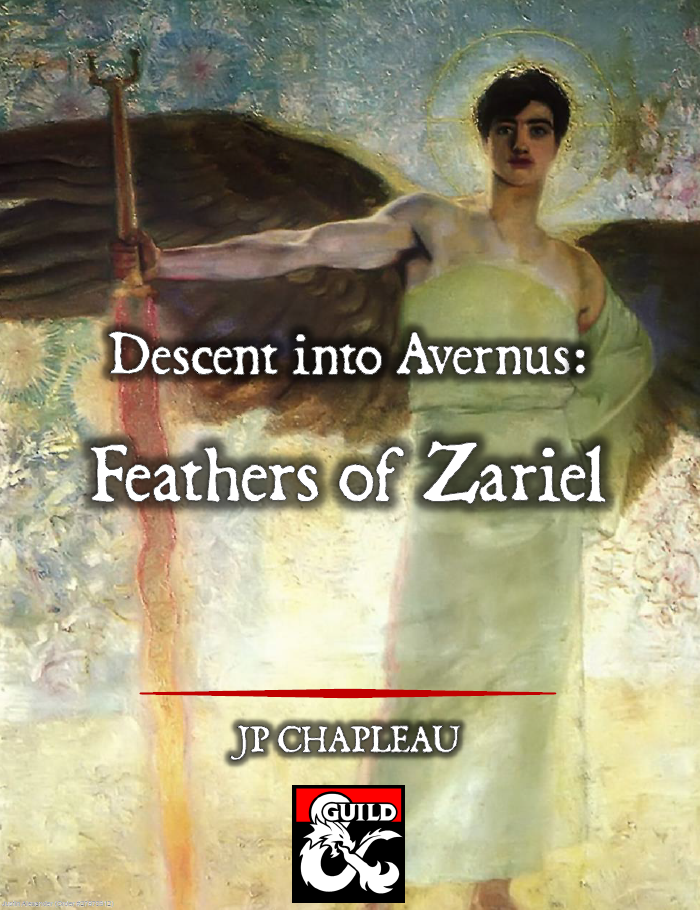 DESCENT INTO AVERNUS – FEATHERS OF ZARIEL: Feathers of Zariel is a seven-page PDF with one page of content and six pages of ads.
DESCENT INTO AVERNUS – FEATHERS OF ZARIEL: Feathers of Zariel is a seven-page PDF with one page of content and six pages of ads.
The basic concept is somewhat interesting: Feathers shed from Zariel before her fall are divine relics, a memory of what Zariel once was. If Zariel can obtain them, she can turn them into dark feathers, corrupting their powers just as she herself was corrupted.
Unfortunately, the execution is completely lacking. The items are ludicrously unbalanced and utterly fail to realize any of the interesting potential of their concept. The bait-and-switch of advertised page count also leaves a bad taste in my mouth.
Note: If you wanted to run with the concept of Zariel’s lost feathers (possibly they were all shed when she fell and scattered throughout Avernus), I’d combine that with the memory mystery of the Remix: Each feather might hold a shard of Zariel’s memory. If Zariel herself prizes them (either because she can transform them into dark artifacts or simply because she wants to secure her memories), they can give the PCs additional bargaining power if they meet her.
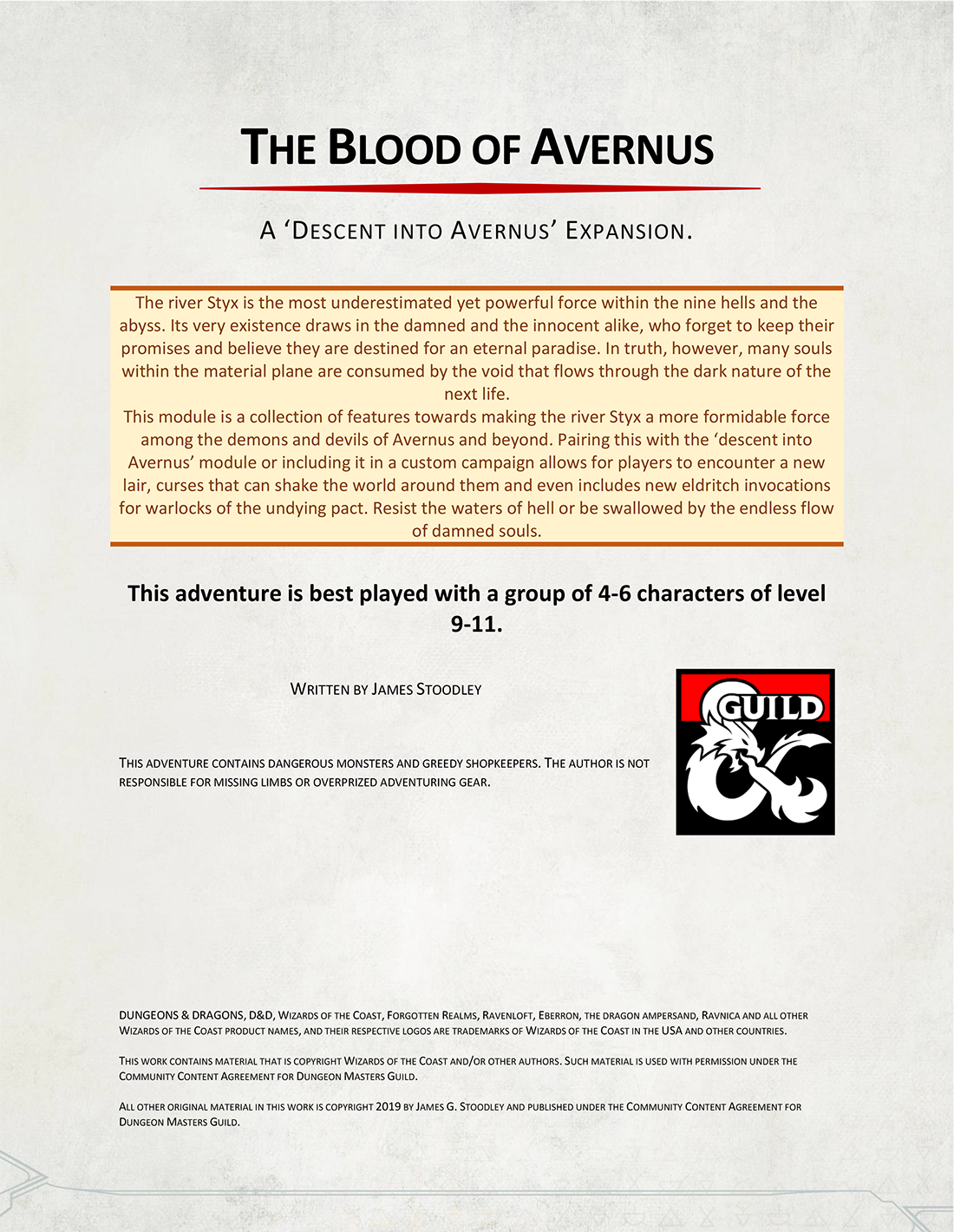 THE BLOOD OF AVERNUS – EXPANDING THE RIVER STYX: This short “adventure” is simply not very good. The tone is set with incredibly poor proofreading and then continued with a rambling, largely incoherent style.
THE BLOOD OF AVERNUS – EXPANDING THE RIVER STYX: This short “adventure” is simply not very good. The tone is set with incredibly poor proofreading and then continued with a rambling, largely incoherent style.
The central conceit reimagines the Styx into a living, demonic entity. Oaths can be sworn to this entity and if these oaths are broken, the Styx will inflict a curse on you. As far as I can tell, the general idea is that one or more of the PCs will swear such an oath and then break it. (How you’re supposed to arrange for that to happen is… vague.)
The avatar of the Styx lives in a cave located… somewhere?
The adventure consists of the PCs journeying to this cave, which is handled entirely as a series of random encounters. Once they reach the cave (which is not described), they can negotiate with the Styx to remove their curse.
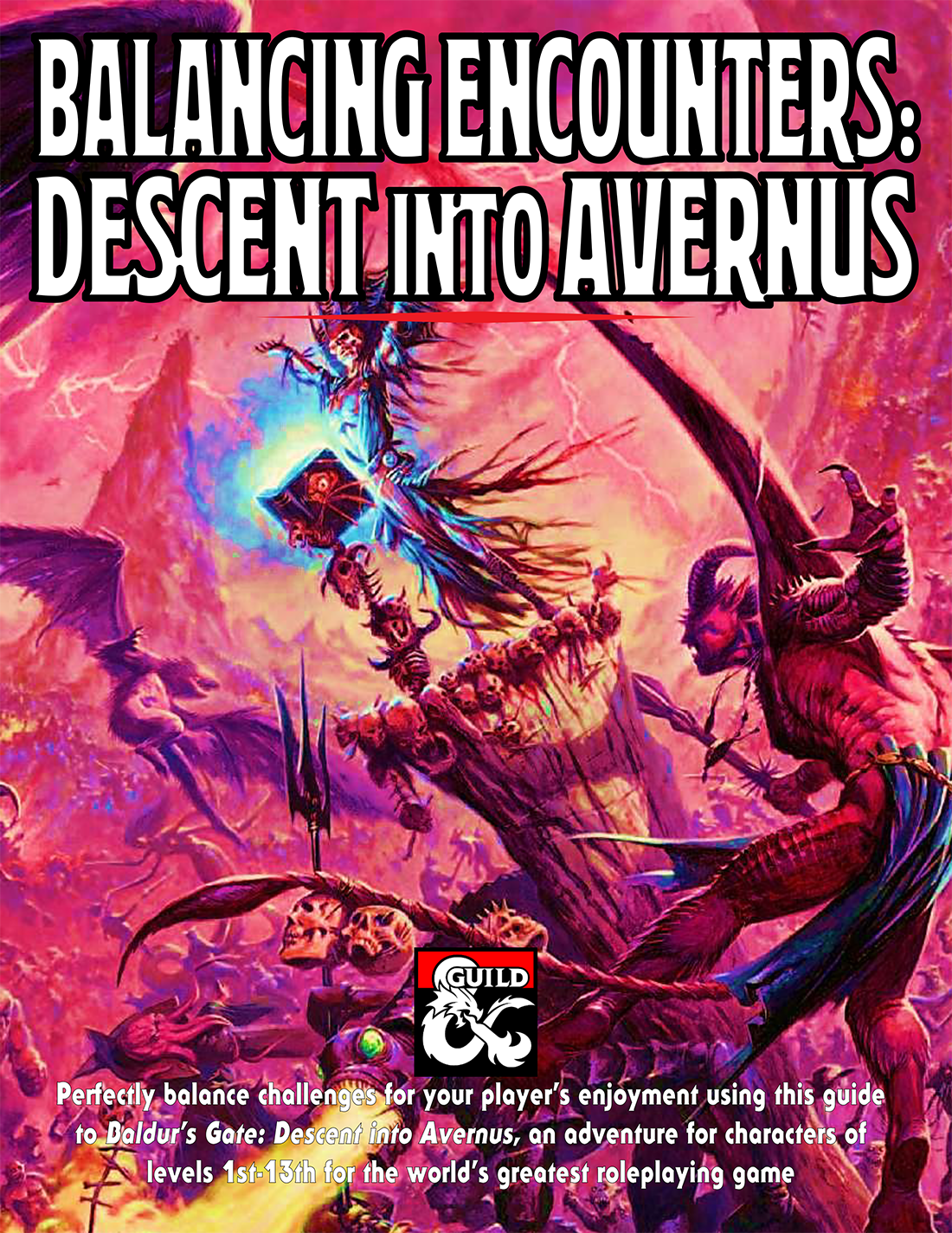 BALANCING ENCOUNTERS – DESCENT INTO AVERNUS: This book includes entries for every single encounter in Descent Into Avernus and provides detailed scaling notes for those encounters based on the relative strength of your group.
BALANCING ENCOUNTERS – DESCENT INTO AVERNUS: This book includes entries for every single encounter in Descent Into Avernus and provides detailed scaling notes for those encounters based on the relative strength of your group.
Fewer players? More players? Lower level? Higher level? Powerful magic items? Stripped naked by a devilish encounter that went awry?
Balancing Encounters will put the encounter you need at your fingertips.
Those of you familiar with the Alexandrian will likely know I don’t put a lot of stock into hyper-precise encounter balancing. But the great range of support given here makes this book useful for far more than just chasing the false idol of the “perfect encounter.” (The introduction of the book actually talks about this.) In addition to providing broad adjustments to radically different groups, the high-powered encounters are also likely to prove useful for anyone wanting to transition to Descent Into Avernus from another adventure, like the approach described in From Waterdeep to Avenus.
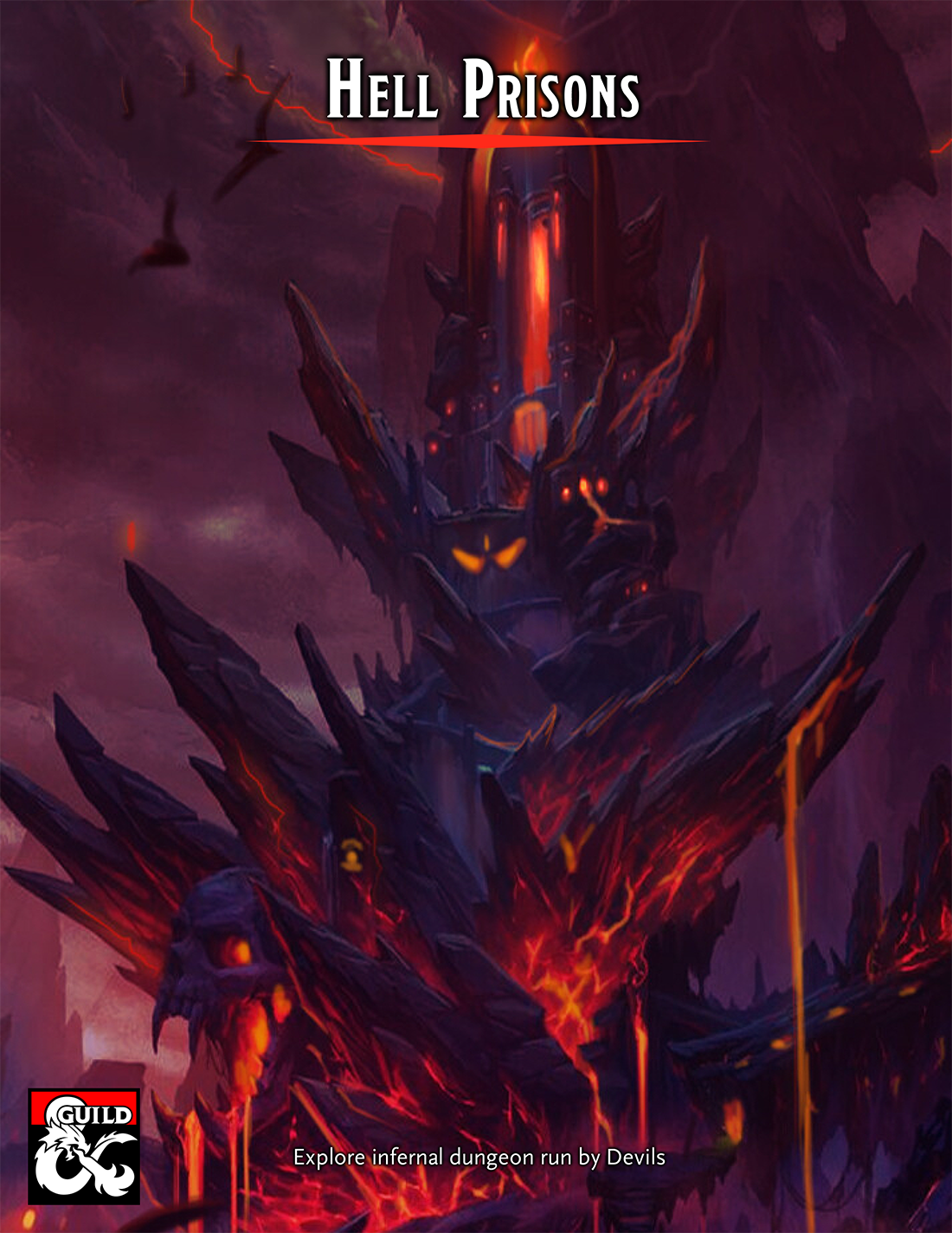 HELL PRISONS: Filp Gruszcyznski has created a really cool mythology in which Hell creates prisons that “purify” the lowly souls of the damned who would otherwise become lemures through torture so that they will “ascend” into more powerful devils for the glory of the Blood War. (And, since they exist, Asmodeus and Zariel use them for other purposes, too.)
HELL PRISONS: Filp Gruszcyznski has created a really cool mythology in which Hell creates prisons that “purify” the lowly souls of the damned who would otherwise become lemures through torture so that they will “ascend” into more powerful devils for the glory of the Blood War. (And, since they exist, Asmodeus and Zariel use them for other purposes, too.)
Gruszcyznski then presents the Hell Prison in a modular format: He includes a sample prison for pick-up-and-play utility, but presents a whole bunch of plug-and-play components – rooms with different functions like Lairs, Prison Wings, Summoning Chambers – that can be combined and re-combined into different layouts to rapidly generate multiple prisons.
The presentation reminds me a little of the old Frontier Forts of Kelnore module from Judges Guild, which similarly presented the concept of ancient imperial border forts built to a common, but customizable plan which had also been turned to various uses (or fallen into ruins) over the centuries since the empire’s fall.
If there’s one thing I’d like to see from Hell Prisons it would be for each modular component to have more pre-built variations. A few of the chambers have this (for example, the Prison Wing has a list of different prisoners who might be held there), but it would be great if more or all of the chambers had 4-6 different variants.
But even without that, this is a really great little book that crams a ton of utility and reusability between its covers.
 WARRIORS OF THE SEHANINE: Warriors of the Sehanine is yet another adventure prominently advertised on the Dungeon Masters Guild as being for use with Descent Into Avernus which (you guessed it) has nothing to do with Descent Into Avernus. I’d ask why creators do this, but obviously it works: They have my money and they’re getting a review out of it.
WARRIORS OF THE SEHANINE: Warriors of the Sehanine is yet another adventure prominently advertised on the Dungeon Masters Guild as being for use with Descent Into Avernus which (you guessed it) has nothing to do with Descent Into Avernus. I’d ask why creators do this, but obviously it works: They have my money and they’re getting a review out of it.
As a module, this is pretty good: A black dragon with an interesting twist has assaulted the fortress of a druidic order. The PCs encounter refugees from the assault and are asked to journey to the fortress and save children who were trapped in the fortress when it fell to the dragon. When the PCs reach the fortress, they discover that other enemies of the druidic order have seized the opportunity to pursue their own agendas.
However, it’s not without shortcomings.
First, it has what I refer to as a pointless hexcrawl. There’s a hex map with several dozen hexes… only four of which have anything keyed to them. Either the PCs will have a map and the hexcrawl is virtually pointless (they are traveling to the fortress, not exploring the forest… which has nothing to discover even if they were exploring). Or the PCs don’t have a map and the assumed form of play is to… wander around aimlessly with the DM periodically saying “you see more trees” until they finally stumble into the correct hex that has the adventure in it? That seems like a poor experience.
Second, the map of the fortress is confusingly incomplete and also missing entries keyed in the text. It’s not incomprehensible, but you’ll definitely have to puzzle your way through it.
Third, the “I’m too wounded and need to recuperate, so you’ll have to go without me” is a gag that doesn’t work in D&D because the PCs will just cast a cure spell.
Fourth, the PCs have one goal: Rescue the kids. They might also decide that they also want to slay the dragon. Oddly both of these goals are keyed to areas directly OUTSIDE the entrance to the fortress, so the adventure kind of ends before it even begins?
However, these quibbles – while somewhat significant – are fairly easy to triage in practice. And there’s a lot of good, meaty material fleshing things out here.
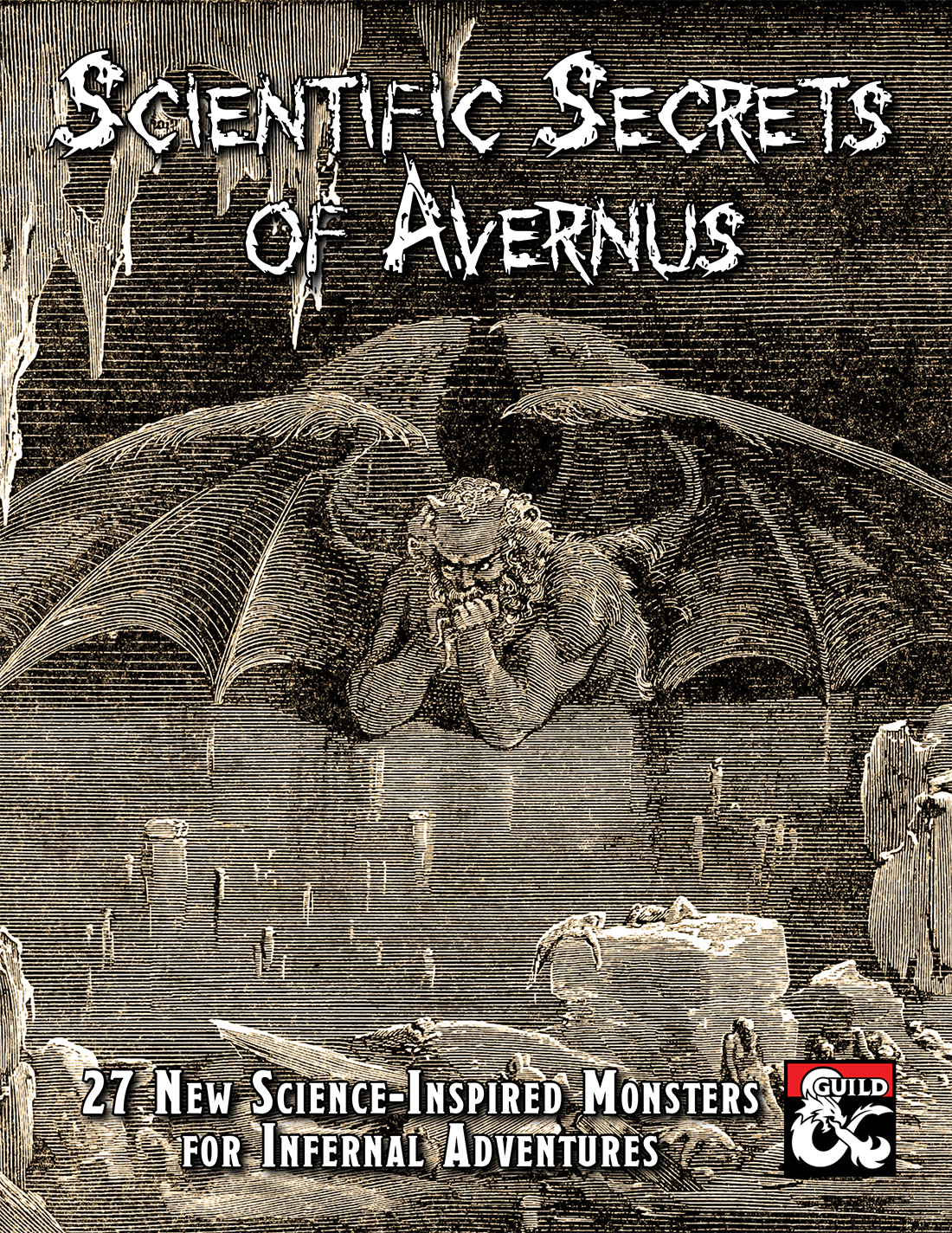 SCIENTIFIC SECRETS OF AVERNUS: This collection of twenty-seven Avernian fiends is built on the gimmick that each monster is inspired by a cool scientific fact, with each entry actually citing a scientific study.
SCIENTIFIC SECRETS OF AVERNUS: This collection of twenty-seven Avernian fiends is built on the gimmick that each monster is inspired by a cool scientific fact, with each entry actually citing a scientific study.
In truth the gimmick is a little thin, with most of the monsters seeming to be only slightly or tangentially related to the scientific source material. (Although it’s a good example of how you can find creative inspiration almost anywhere.) But the actual monsters have a pretty good hit rate, which is, of course, the key measure of value in a monster manual.
Some of my favorites in Scientific Secrets of Avernus include the cranium crabs (soul-devouring devil crabs using skulls as their shells), malebranches (canid devils who gather errant lemures and drag them in chains across Avernus), flesh-eating splendors (swarms born from the cursed flesh of a succubus that seek to destroy beauty), and the screaming ash elementals (which steal the voices of their victims’ screams).
More DMs Guild Capsule Reviews – Go to the Avernus Remix






















